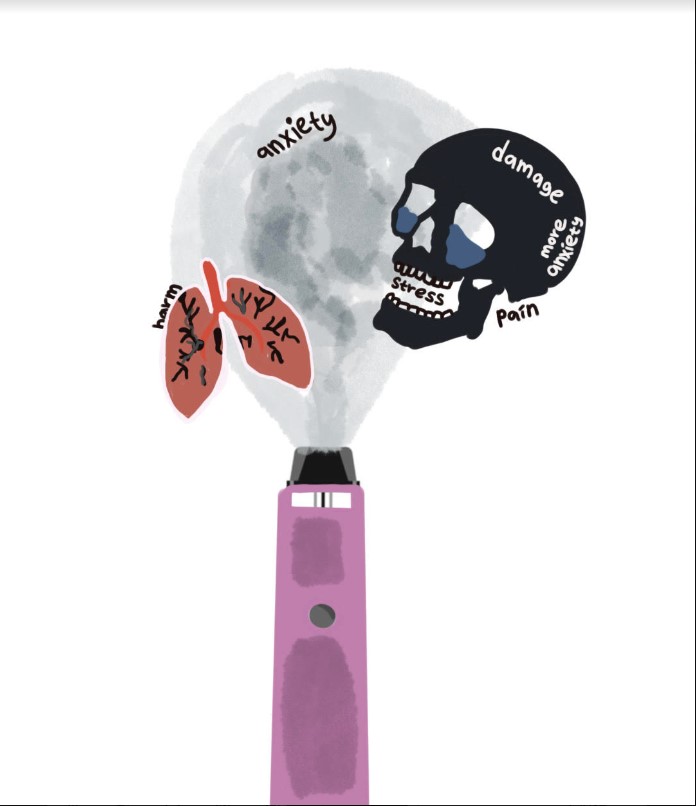In recent years, anti-nicotine advertisements have increasingly targeted teenagers online, which comes amid the rising popularity of e-cigarettes and vapes among youth. Particularly, the Woodbridge High community has noticed the prevalence of these anti-nicotine advertisements aiming to discourage youth from trying nicotine products, but their effectiveness remains up for debate.
Anti-nicotine ads have been seen across all media: social media, television commercial breaks and even in the checkout aisle of a grocery store’s newspaper rack.
Junior Sophia Ahsan has received anti-nicotine ads from across a variety of different platforms.
“Sometimes I’ll get [the ads]… on YouTube…when I’m trying to listen to a video. Sometimes I’ll get it in magazines or whatever but it’s very rare. It’s mainly online and sometimes through social media like Instagram,” Ahsan said.
Junior Bianca Alvarez also gets anti-nicotine ads, however, mainly on YouTube. The ads she described appeal emotionally to teenagers by creating situations many adolescents can relate to in a high school setting.
“There’s a bunch I’ve seen about stress, how [using nicotine products] increases stress, and depression and anxiety, and I feel like the majority of the especially high schoolers struggle with that,” Alvarez said. “So, I think that bringing up those points really hits home for a lot of teenagers.”
There are different faces behind the anti-nicotine campaigns; the Centers for Disease Control and Prevention (CDC), the Food and Drug Administration (FDA), and Truth Initiative, a nonprofit tobacco and nicotine organization, are some of the prominent characters in pushing out ads. In 2017, court orders forced tobacco and nicotine product companies to sponsor ads for prevention.
Anti-nicotine advertisements are not just a new fad. In fact, they have been around since the 1960s. According to the National Library of Medicine (NLM), anti-tobacco and nicotine advocates have utilized advertisements on television, magazines, billboards and even celebrity spokespersons for years. Using social media platforms is just a modern form of these long-lived campaigns.
Health and yoga teacher Jessica Shipma says that anti-nicotine ads can positively impact the community if they are done right.
“I think when [anti-nicotine advertisements are] done right…they can have a positive impact on young people, whether…[they have] never [picked] up a vape or a cigarette in their life. [T]eenagers who have tried nicotine products and [have] had access to them in one way or another…[Anti-nicotine ads] are hopefully stopping that cycle and preventing addiction from taking over,” Shipma said.
According to the FDA, 2.8 million youths in the United States, but the FDA states that the high school student use of tobacco has decreased from 16.5% to 12.6% from 2022 to 2023. This is because fewer high schoolers are using e-cigarettes. The decrease is attributed to more states signing flavored tobacco bans into law in retail stores and the immense campaigning in advertisements from anti-nicotine groups.
Alvarez holds a more cynical view regarding the effectiveness of the ads and whether or not the ads are the reason why there has been a decrease in usage. Instead, she focuses on the influence of personal anecdotes and advice on the direct community.
“I feel like hearing it from your peer is a lot more effective than an ad who is far from you,” Alvarez said.
Ahsan believes that some teenagers will just take the cautionary tales of anti-nicotine advertisements with just a grain of salt and continue to engage in nicotine usage.
“It’s just that some people won’t necessarily take [anti-nicotine ads] seriously…they’ll see it, but it won’t really register…and they’ll just keep doing the same thing,” Ahsan said.
On top of advertisements, Shipma feels that education in Woodbridge High’s health classes is a great preventative in stopping nicotine usage.
“I’m hoping through my class and through that information. Hopefully, the students at Woodbridge [High] will be able to make healthier choices,” Shipma said.
Shipma has optimism about the future and believes that these ads are just a start to bringing more awareness in advising teens about the dangers of vapes and other nicotine products.
“I think it’s a great thing that there’s more of an effort being made to educate young people on the dangers of these electronic tobacco products because there was such a big push to educate people about the dangers of cigarettes, and then the cycle kind of started all over again, the new generation,” Shipma said.









